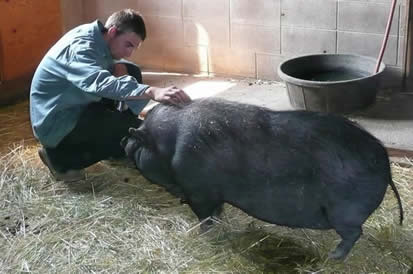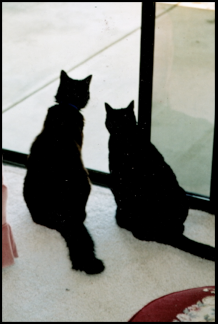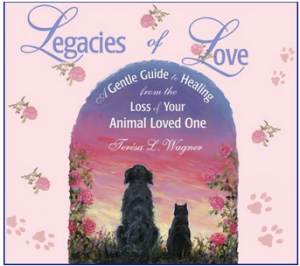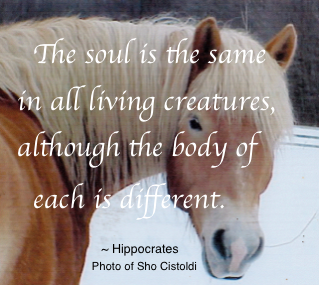On July 31, 2008, near the time of the Big Sur fires of 2008 becoming contained, I had the pleasure of interviewing Lt. Rosanna Leighton, who at the time was a member of the Humane Investigations department of the SPCA for Monterey County in California. She is now Vice President of Operations. Our conversation follows:
Teresa:
As I sat in my house in Big Sur, anxiously smelling smoke and watching the spread of the fires on Google Earth each day for weeks, I was acutely aware that many animals would be impacted. What kinds of animals was the SPCA involved in helping–wildlife, livestock, companion animals?
Rosanna:
Of course there were many cats and dogs. And also horses, pigs, goats, sheep, chickens, roosters, llamas, rabbits, fish, cattle, turkeys, a fox, a turtle, a gecko and a parrot. Most wildlife in such disasters know to flee the area or are able to take safe cover in caves or borrows, but we were called in to help an injured fox, some geese and a pigeon. (Note: The SPCA Wildlife Center admits and cares for over 2,000 wild animals every year)
Teresa:
How many animals was the SPCA involved with helping during the fires? I’ve heard that sheltering of animals was free. Is that correct?
Rosanna:
Altogether, we worked with 404 animals. And yes, it is correct that both the rescuing and physical sheltering are at no cost to the owners. We were also able to procure large amounts of pet food and provide it at no charge to the pet owner residents of the impacted area, knowing that many of them lost work and income during the fires. We wanted to make it as easy as possible for them to continue to care for their animals after getting back into their homes. Overall, people were enormously appreciative of our help. This is one of the things that makes our jobs especially rewarding.
Teresa:
Are the animals that have been sheltered reunited with their families now? Why or why not? During the Katrina disaster and its aftermath, I remember reading and hearing a lot about how the majority of the animals rescued had no collars, tags or microchips and which made it awfully difficult for rescuers to facilitate reunions. Was that an issue in this fire crisis?
Rosanna:
As of today, 150 Animals have been returned to their owners. We aren’t experiencing a lot of challenges with unidentified animals because in this crisis most people had prior warnings for evacuation and either took their animals with them, then asked us for sheltering help, or, they called upon us for help to get their animals out. So for the most part, we knew which animals belonged with which people. Many of the animals we have helped were given to us by the owners for temporary shelter help during evacuation. Though there was one instance of a cat roaming along the highway without a collar, tag or microchip. A reporter found this cat near a hotel in Big Sur, called us, and we came to get the kitty. Not long after this, we received a phone call from the owners asking if we had their cat because they could not find her. It was heartwarming to know this reunion occurred. We also rescued a puppy found roaming near Arroyo Seco. without tags or a microchip. Because he was without tags or a microchip, and, no one has come forward to claim him, he will be put up for adoption after a period of time.
Teresa:
Because you see the fire’s impact on animals so directly, what if anything, would you advise people to do to keep their animals out of harm’s way during natural disasters? What can and should we be doing as guardians of our companion animals (and livestock) to keep them safe?
Rosanna:
We strongly recommend that when people evacuate to take their animals with them. It’s important that people understand that any situation that is dangerous for them, is also dangerous for their animals. It’s ideal for people with horses or livestock to have their own trailers to be able to get their animals out quickly and safely. Short of this, it’s important to have pre-arranged plans with neighbors or friends with trailers who have agreed to help in crises. It’s important to have a well thought out disaster evacuation plan for all animals. Most importantly, never wait until the last minute to take action.
Our Director of Operations, Lisa Hoefler, began collaborating with our local chapter of the American Red Cross during the severe floods we experienced in 1995. This resulted in allowing displaced people to bring their animals with them to Red Cross shelters. This was never permitted before. During this current fire crisis, we had what are called co-locations with the Red Cross in four areas of the county. At each location we had crates of all sizes, bowls, food, water, litter boxes, etc, essentially creating a temporary animal shelter outside of the Red Cross shelter so people can know their animals are being safely cared for during an evacuation. Even for people who did not need to sleep at the Red Cross shelter, hundreds of them came for other services during the day. At these times, we had staff and volunteers available to stay with their animals, walk them, etc. so they do not need to stay confined in a vehicle or tied somewhere outside the Red Cross shelter. We also offer free sheltering and care of the animals at our permanent facility for as long as it may be needed while evacuees get back on their feet. Before this arrangement was made, whenever a natural disaster occurred, people were told to leave their animals behind because they would not be allowed at the Red Cross shelters. One of our goals is to make sure that all Monterey County residents know that they do NOT need to and should not leave their animals behind. The SPCA will help them get their animals out when necessary, we will help them stay together whenever possible, and we will care for the animals when they cannot.
Getting back to the trailering issue, we anticipated that not everyone with large animals would be able to or be prepared to get their animals out. Lisa was in continual 24/7 contact with CALFIRE and USFS regarding when livestock would need to be evacuated as the fires got closer to certain ranches and residences. She arranged for 16 different sites around the county–rodeo grounds, private homes and ranches–with a total capacity for 566 horses, cows, goats, sheep, pigs, etc.–could be taken if and when necessary. Of course, every facility was different and had certain limitations regarding what type of animals would be appropriate and how many could be cared for. It wasn’t simple. In addition to our own trailers we were blessed to have 32 people with trailers volunteer to come with us to create a staging area at several of the fire sights. Together, we were prepped and ready to get the large animals out when necessary. Importantly, all livestock in need was moved safely and in an orderly manner in advance of fire vehicles having to use the roads.
Another thing that’s critical in these situations is to have companion animals identified. We strongly recommend that all animals be microchipped, and that dogs and cats always wear break away collars with tags. An ID tag on a dog or cat facilitates easy identification and reunion. Additionally, we recommend that all pet owners keep some Jiffy ID tags in their disaster kit that can be filled out on the spot if evacuation becomes necessary. In leaving one’s home, it is likely that your contact number may change to a friend’s home, a hotel, the Red Cross Center, etc. ID tags and microchips are a lost animal’s ticket home. Natural disasters like fire, flood, and earthquakes create a sensory overwhelm for animals–unusual smells, sights, sounds, etc. that can make them very scared and jump our of our arms or run away.
In cases like this fire where we did have some warning period that mandatory evacuations may be forthcoming, it’s a good idea during such “be prepared to evacuate periods” to keep cats and dogs inside, ready for easy evacuation. This is especially true for cats who we know do not tend to come when called, and may run off when frightened by smoke, the noise of fire equipment and the general chaos of unusual activity. Though indoor/outdoor cats may be unhappy kept inside for a short time, they stand a much greater chance of being rescued–and surviving– from a house than from outside in the wilderness (or anywhere outside, even a suburban area).
Teresa:
Being on the front lines of this situation rescuing animals in the field, are there any particular animals that touched your heart, or stories that you’ll never forget about your role in all this?
Rosanna:
Well, you may have heard of Daisy, the 350 pound pig. Her rescue has been a popular subject in our local papers. Her owners live in Partington Ridge. When they needed to evacuate, four people attempted to lift Daisy into a truck but they simply could not do it. So they had to evacuate without her. The SPCA was contacted to help get Daisy out. Traveling to the property to get Daisy involved driving about ten miles an hour on a very narrow, steep, pot holed, one lane dirt road. Smoke from the fires was all around us, and we were aware that at any moment we may have to figure out a way to get off this narrow road if a fire engine came through. It was pretty tense. When we finally arrived–myself, one other humane officer and a firefighter–and found Daisy, I soon realized we would not be able to lift her either. To help get her to safety, I asked the fire fighter with us if he could get a few additional firefighters to help. More came.
When we got there Daisy was hunkered down in her pig house. As we walked around her and tried to figure out how to get her out of there and lifted into a truck, she began squealing continuously, seeming pretty scared and unhappy about all these strangers surrounding her. She sure didn’t seem to want to leave her house. Daisy had lived in this property for fourteen years–her whole life. And now her people and other animals were gone and the air was filled with smoke.
What we ended up doing was having a few of us get behind her little house and pound on it a bit to coax her leave it. When she came running out of it, several of us were holding up a large blanket like a wall. When she got near this, we quickly dropped the blanket over her, rolled her on her side, and wrapped her up, sort of like a burrito–a BIG burrito!. It took two humane officers and seven fire fighters to then lift Daisy into a pick up truck (our SPCA van would not have made the trek on this road). But we finally got her in a truck!
Pigs are not naturally happy about being in air so even this somewhat brief time being lifted seemed to scare her more. After getting her in the truck we then had the trip back down the dirt road to our SPCA van at the staging area on the highway. To get her from the pick up into our van, we all worked together to walk her across from truck to van, sort of like a bridge. Inside the van, we nestled her with lots of blankets and bales of hay so she would be as comfortable as possible and to prevent her from sliding around during the one hour drive to our facility. She did seem to calm down once in the van. When we arrived at the SPCA, we created steps with bales of hay from our van to her area in our barnyard so she could easily walk down to it.
Daisy is now happily housed at our shelter, getting a lot of TLC from staff and volunteers. We have another pig, Scarlett, who was surrendered to the SPCA by other people, unrelated to the fires. Daisy shares space with Scarlett and the two have become great buddies! Daisy’s people are now considering adopting Scarlett and taking her home when they can return to their property. So it looks like Daisy might be getting a new pig sibling!
Teresa:
I love hearing about Daisy and your work to save her life! Thank you! And I am also wondering, Rosanna, what was this experience like for you personally? What’s it like being told you’ve got to go rescue a 350 pound pig on the top of a steep ridge right next to the raging fire?
Rosanna:
Well, sometimes in our job we really do have to fly by the seat of our pants to figure out how to help a particular animal in a situation we never encountered before. We never know what we will get, who needs to be helped, or under what circumstances. Though we all receive extensive training in humane investigations, and certainly there are procedures, there is no manual that covers every contingency, every unique situation and circumstance.
Every problem is different and it takes some on the spot, spontaneous, creative problem solving and decision making. But you know, there is nothing like helping animals get out of a situation like this, helping solve the problems about the animals left when people are unable to get back in after mandatory evacuation. It’s really gratifying. This is the most rewarding job I’ve ever had, because we get to make that little bit of difference for the animals.
Teresa:
Thank you so much Rosanna, for your time and for saving the lives of a lot of so many animals in this crisis. You, and all of you who do this work will always be heroes to me.
NOTE FROM TERESA:
The next time you see a Humane Officer or Animal Control Officer, you may want to take a moment to thank them for saving the lives of animals in your community. They are the folks who not only save lives during natural disasters, but are out in our cities, towns and rural areas every day, rescuing injured wildlife, rescuing lost and stray cats and dogs, providing humane education for school children, and investigating cases of animal cruelty and neglect.
Sometimes their lives are in danger, sometimes they are injured. And many times over their hearts break as they witness neglect, abuse and cruelty first hand. This up close and personal exposure to the dark side of human behavior toward animals takes a great deal of inner strength and an unshakable love for animals, or they couldn’t do it. The pain of seeing the results of abuse and cruelty first hand is far, far greater than what most of us experience just reading these abuse stories. And we all know how hard that even that can be.
The next time you see a Humane Officer in your community, you might want to thank them for loving animals enough to do this tough job. During this fire crisis, these workers were putting in 15-16 hour days for several weeks straight. I asked Lisa Hoefler, Director of Operations for the SPCA, who served as the “command central” point person during these fires for all animal related requests for help, what her days were like during this time. She said she fielded an average of 67 calls per day, 7 days a week for about 4 weeks, with a peak day of 148 calls on one day.
Like firefighters, staff from animal shelters work incredibly hard, sometimes at risk to themselves, to save our beloved animals. To people like Lisa and Rosanna and thousands like them around the world, this work is just what they do–because they love animals.
During a major flood in this area in 1995, Lisa Hoefler and another humane officer, walking in hip boots in flood waters already above their knees, rescued my own beloved cat KK from the roof of a house. Without the SPCA’s intervention, he would not have survived and I would not be blessed by his presence and love. I will forever be grateful. The SPCA rescued and saved the lives of 90 animals in the flood that same day.
If you ever wonder, which animal organizations to donate to, consider supporting your local shelter or humane society. Mine is the SPCA for Monterey County.



 Thank you for visiting my blog. It is a place for me to share stories from and about animals, love, loss and healing. The articles are primarily written by me, but some are from my colleagues who have graciously allowed me to share their words here.
Thank you for visiting my blog. It is a place for me to share stories from and about animals, love, loss and healing. The articles are primarily written by me, but some are from my colleagues who have graciously allowed me to share their words here. 


